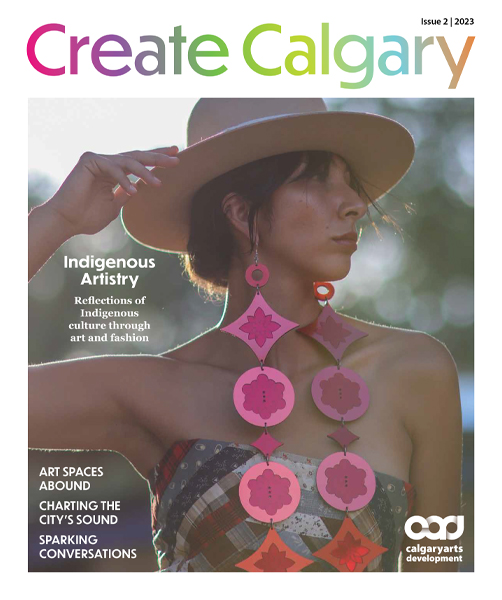Telling Our Stories
The importance of sharing Indigenous culture through art and fashion
It’s been nearly 30 years since my first exhibit with the Glenbow Museum, as a student at the Plains Indian Cultural Survival School. It was the first time that I got to actually hold the cultural artifacts from my ancestors. It was an opportunity for Indigenous students and artists to go through the Glenbow’s Indigenous collections and use the artifacts to tell a story of our heroes. Called the Circle of Honor: Our Heroes Give Us Hope exhibit, for most of the students it was an introduction to their own heritage and culture.
As someone who was obsessed with fashion, I couldn’t wait to get close to the women’s elk tooth dresses, beaded moccasins, dyed quill work and shell earrings. What I found the most fascinating is how our people adapted the materials of western culture into our own art forms. Whether it was glass beads, velvet, ribbons, metals or acrylic, our Indigenous fashion designers have always been innovative and groundbreaking.
Could our ancestors have ever imagined that the Indigenous designers of Treaty 7 would now travel the world to showcase their work? It has been an incredible year for Indigenous designers here in Treaty 7, especially when it comes to fashion. They’re out on the world stage making a name for themselves and selling their unique brands of style and haute couture. Within our own local community, designers have been perfecting their craft and skills in traditional and contemporary beadwork, jewellery making and sewing, knowing how unique their contribution to fashion has been and continues to be.

Left: Garment by Amy Denning and Josh Tafoya, earrings by Indi City, hat by ThunderVoice Hat Co., styling by Angel Aubichon | Photo by Alanna Bluebird. Model: Midnight Lujan.
Right: Maskiki earrings by Indi City | Photo by Jenna Pullen.
For thousands of years, our ancestors have been living a creative life. Today, the landscape and diverse community of Calgary/Mohkinsstsis and southern Alberta continues to nurture and inspire Indigenous artists from Treaty 7 First Nations and from Nations throughout Turtle Island who make Calgary their home. Angel Sanderson and Alex Manitopyes of Indi City have travelled all the way to Japan to showcase their jewellery collection. Their work has been on the red carpet at the Emmys, worn by actor Devery Jacobs, who plays one of the main characters on Reservation Dogs.
Sisters Melrene Saloy EagleSpeaker and Autumn EagleSpeaker created their Authentically Indigenous Markets to help fellow Indigenous traditional and contemporary artists promote and sell their work. Saloy EagleSpeaker has showcased her jewellery and designs on the runways of Paris as well as at the 2023 New York Fashion Week. And it’s not just Indigenous fashion that has been taking off. The same is happening in all mediums and practices such as film, music, theatre, dance and literature.
This surge of creativity and entrepreneurship is taking place across Canada and has been happening alongside the truth and reconciliation journey of many Canadian institutions and individuals. It has helped to increase the awareness and popularity of the work of Indigenous designers amongst non-Indigenous Canadians. I have started seeing more Calgarians wearing earrings from Authentically Indigenous Markets and made by Indi City, mostly because they are fabulous and exquisitely beautiful, but also because they seek to support the authentic work of Treaty 7 artists.
We have come a long, long way from the days of the late 19th and early 20th century when museum collectors filled their museums with artifacts hoping to preserve what they saw as dying cultures. In fact, Indigenous cultures were not dying; they were being suppressed and oppressed. In spite of that, they were adapting and quietly carrying on the traditional practices of our ancestral artists. Unlike western art that traditionally silos itself from other professions and ways of knowing, Indigenous art infuses itself into every part of society and ceremony. The work that our artists create is functional, educational, inspiring and spiritual.
Sable Sweetgrass is Blackfoot and a member of the Kainai Nation in Southern Alberta, born and raised in Calgary/Mohkinsstsis. Sweetgrass is a writer/storyteller dedicated to the growth and success of the local Indigenous arts and culture community in Mohkinsstsis and Treaty 7 Territory. A graduate of the University of Calgary’s creative writing program, she also received her MFA in creative writing from the Institute of American Indian Arts in Santa Fe, New Mexico. She has written an award-winning short story for Indigenous Arts & Stories and an award-winning essay for New Forum magazine. She has also written and performed for Making Treaty 7 and her first play, Awowakii, is being produced by Theatre Calgary. Sweetgrass also serves the arts community as the director of engagement and reconciliation at Calgary Arts Development.

This article was originally published in the 2023 edition of Create Calgary, an annual magazine launched by Calgary Arts Development in 2022 to celebrate the work of artists who call Mohkinsstsis/Calgary home.
You can pick up a free copy at public libraries, community recreation centres and other places where you find your favourite magazines. You can also read the digital version online here.
